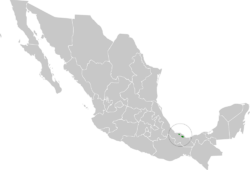Biology:Tuxtla quail-dove
| Tuxtla quail-dove | |
|---|---|

| |
| Scientific classification | |
| Domain: | Eukaryota |
| Kingdom: | Animalia |
| Phylum: | Chordata |
| Class: | Aves |
| Order: | Columbiformes |
| Family: | Columbidae |
| Genus: | Zentrygon |
| Species: | Z. carrikeri
|
| Binomial name | |
| Zentrygon carrikeri (Wetmore, 1941)
| |

| |
| Synonyms | |
|
Geotrygon carrikeri | |
The Tuxtla quail-dove (Zentrygon carrikeri) is a species of bird in the family Columbidae. It is endemic to southeastern Mexico.[1]
Taxonomy and systematics
The Tuxtla quail-dove is monotypic.[1] It and the purplish-backed quail-dove (Zentrygon lawrencii) of Central America were previously considered conspecific.[2]
Description
The Tuxtla quail-dove is 20 to 31.5 cm (7.9 to 12.4 in) long. The adult's head, neck, throat and breast are light bluish gray and the flanks light brown. It has a wide black malar stripe. Its back and wings are olive brown with little iridescence. Juveniles are darker all over with cinnamon edges to the upperparts' feathers and buff bars on the breast.[2]
Distribution and habitat
The Tuxtla quail-dove is found only on two volcanoes in the Sierra de los Tuxtlas of southeastern Mexico's Veracruz state, Volcán de San Martín and Sierra de Santa Marta. It inhabits humid evergreen forest and cloudforest at elevations between 350 and 2,100 m (1,150 and 6,890 ft).[2]
Behavior
Feeding
The Tuxtla quail-dove forages singly or in pairs. No details of its diet have been published but it probably feeds on fruit, seeds, and invertebrates found in leaf litter.[2]
Breeding
The only documented Tuxtla quail-dove nest was a loosely constructed platform supported by bamboo shoots; it contained one egg.[2]
Vocalization
The Tuxtla quail-dove's song is "a three-syllable note 'whu-hu-whUuuw', with a clear emphasis on the last syllable." The overslurred last syllable is all that is usually heard at a distance.[2]
Status
The IUCN has assessed the Tuxtla quail-dove as Endangered due to its very small and fragmented range that has undergone almost complete deforestation.[3][2]
References
- ↑ 1.0 1.1 Gill, F.; Donsker, D.; Rasmussen, P. (July 2021). "IOC World Bird List (v 11.2)". https://www.worldbirdnames.org/.
- ↑ 2.0 2.1 2.2 2.3 2.4 2.5 2.6 Baptista, L. F., P. W. Trail, H. M. Horblit, P. F. D. Boesman, and E. F. J. Garcia (2020). Tuxtla Quail-Dove (Zentrygon carrikeri), version 1.0. In Birds of the World (J. del Hoyo, A. Elliott, J. Sargatal, D. A. Christie, and E. de Juana, Editors). Cornell Lab of Ornithology, Ithaca, NY, USA. https://doi.org/10.2173/bow.tuqdov1.01 retrieved September 23, 2021
- ↑ Cite error: Invalid
<ref>tag; no text was provided for refs namedIUCN
External links
Wikidata ☰ Q27074683 entry
 |


